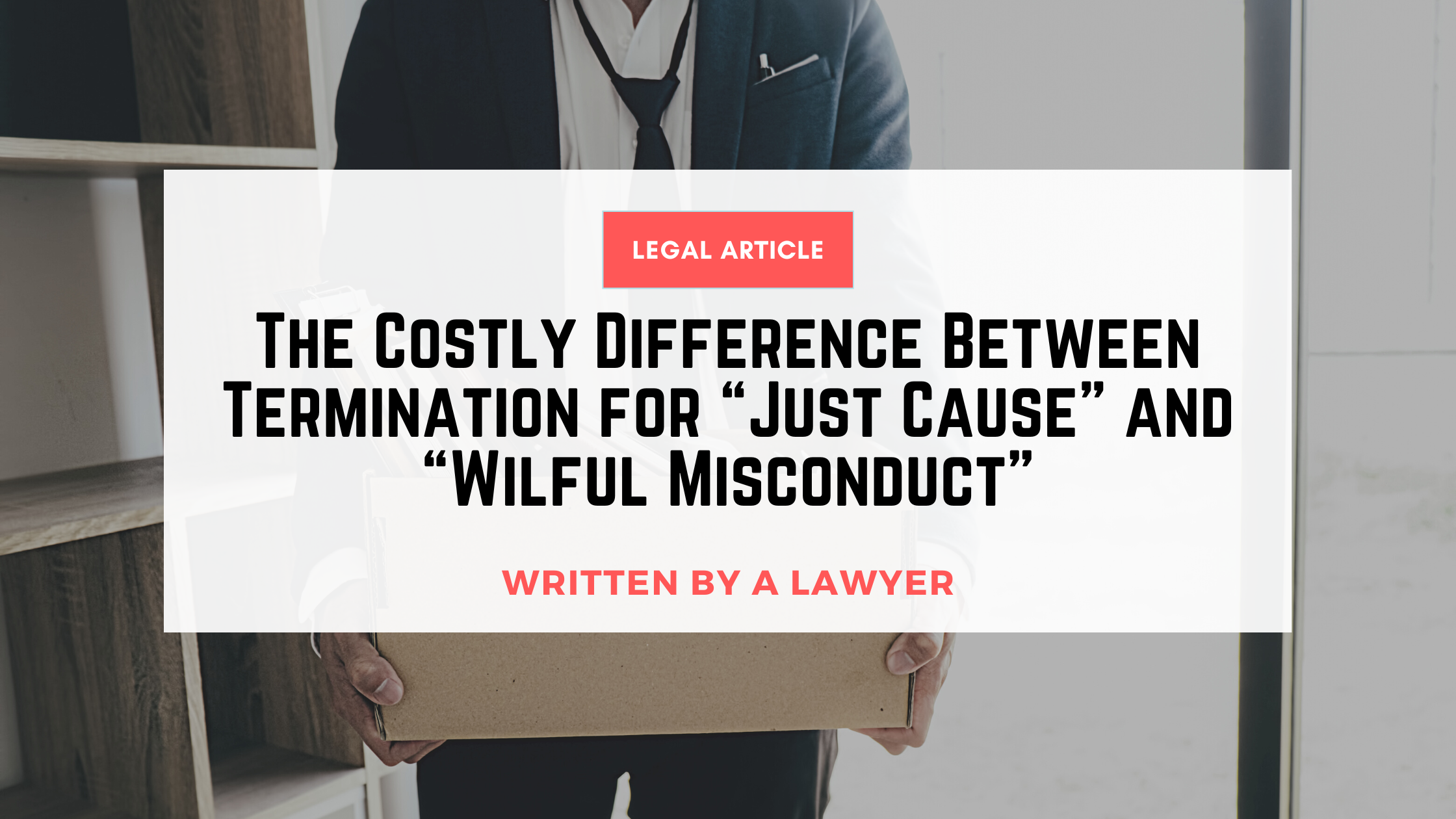The Ontario Court of Appeal recently had an opportunity to re-visit the distinction between “wilful misconduct” and “just cause” in the case of Render v. ThyssenKrupp Elevator (Canada) Limited, 2022 ONCA 310. The Court’s final determination and their analysis may surprise you.
Background on Termination: ESA vs Common Law
In Ontario, the Employment Standards Act, 2000 (“ESA”) states that an employee can be terminated without being provided with any notice of termination or pay in lieu of notice where they have been found guilty of:
“wilful misconduct, disobedience or wilful neglect of duty that is not trivial and has not been condoned by the employer” (ESA, O. Reg 288/01)
By contrast, the common law – aka judge made law – standard for terminating an employee without providing notice of termination or pay in lieu of notice is for “just cause”. Just cause can include an employee’s inadvertent or careless actions which warrant immediate dismissal without notice or pay in lieu of notice.
The ThyssenKrupp Case
In this case, a long-standing employee, Mr. Render, was accused of slapping a female co-worker’s behind during work hours and in the presence of other male employees.
The female co-worker complained to HR. Mr. Render at first said that the slap was “playful” and the employees at the workplace liked to joke around in this fashion. In fact, other male employees slapped each other on the behind often and said “good game” to each other. Later, during his interview as part of the harassment investigation, Mr. Render claimed that the slap was accidental and was not purposeful.
ThyssenKrupp undertook a workplace investigation into the complaint of sexual harassment, which resulted in a finding that Mr. Render had violated ThyssenKrupp’s sexual harassment policy and engaged in sexual harassment. Mr. Render was terminated without notice or pay in lieu of notice and he subsequently sued the company for wrongful termination.
At trial, the Court found that Mr. Render’s conduct constituted wilful misconduct and his termination without notice or pay in lieu of notice was warranted. Mr. Render appealed the trial judge’s decision.
The Court of Appeal, while being careful to denounce Mr. Render’s behaviour, ultimately found the behaviour not to have risen to the higher standard of “wilful misconduct”. The Court had this to say:
“While the trial judge found that the touching was not accidental, he made no finding that the conduct was preplanned. Indeed, his findings with respect to the circumstances of the touching are consistent with the fact that the appellant’s conduct was done in the heat of the moment in reaction to a slight. Although his conduct warranted dismissal for cause, it was not the type of conduct in the circumstances in which it occurred that was intended by the legislature to deprive an employee of his statutory benefits”
In other words, while reprehensible, Mr. Render should have been provided with the minimum notice or pay in lieu of notice in accordance with the ESA, which affords terminated employees with notice entitlements of approximately 1 week of pay for every year worked, up to a maximum of 8 weeks.
The Court also clarified that unlike the common law “just cause” standard, where the employee either knew or ought to have known their behaviour was worthy of termination, the more strict legislative burden of “wilful misconduct” involves an assessment of “subjective intent” of the employee that will not always be found in cases where “just cause” is made out.
The Court further clarified that, “Careless, thoughtless, heedless, or inadvertent conduct, no matter how serious, does not meet the [legislative] standard. Rather, the employer must show that the misconduct was intentional or deliberate. The employer must show that the employee purposefully engaged in conduct that he or she knew to be serious misconduct. It is, to put it colloquially, being bad on purpose.”
What Does This Mean for Employers?
Simply put, in all cases where an employee behaves badly and the employer is contemplating termination it is incumbent on the employer to ask themselves:
- Was the behaviour inconsistent with continued employment?
and
- Did the employee intend to misbehave?
If the answer to the first question is affirmative, then the employer must undertake an analysis of the second question.
If the answer to (b) is affirmative, then a termination without any notice or pay in lieu of notice will be warranted. However, if the answer to (b) is negative, then the employee should be terminated with at least minimum notice of termination or pay in lieu of notice in accordance with the ESA.
Final Thoughts
Although this case is a re-statement of already established law regarding the difference between just cause and wilful misconduct terminations, this decision has come under fire for failing to take into account the extraneous factors that point directly to Mr. Render’s “subjective intent” and prior knowledge that what he did was wrong including: (a) Mr. Render having received workplace harassment training mere weeks before the incident took place; (b) speaking with the victim after the incident to apologize for his behaviour; and (c) changing his story during the workplace investigation regarding the slap being accidental versus purposeful. It will be interesting to see if this case is further appealed. For now, we advise our clients this: do not terminate an employee “for cause” or for “wilful misconduct” before speaking with a lawyer, doing so can be a costly mistake!
About the Author
Ljubica Durlovska is an Employment Lawyer at HRC Law Professional Corporation. With a passion for employment and labour law, she has spent many years helping employers with a wide range of workplace issues, including assisting clients with employment contracts, discipline, investigations, policy development, accommodation, termination, and employment-related human rights and health & safety matters. Ljubica also has previous experience in corporate/commercial law and leasing.
Contact Ljubica at: ldurlovska@hrcemploymentlaw.com

